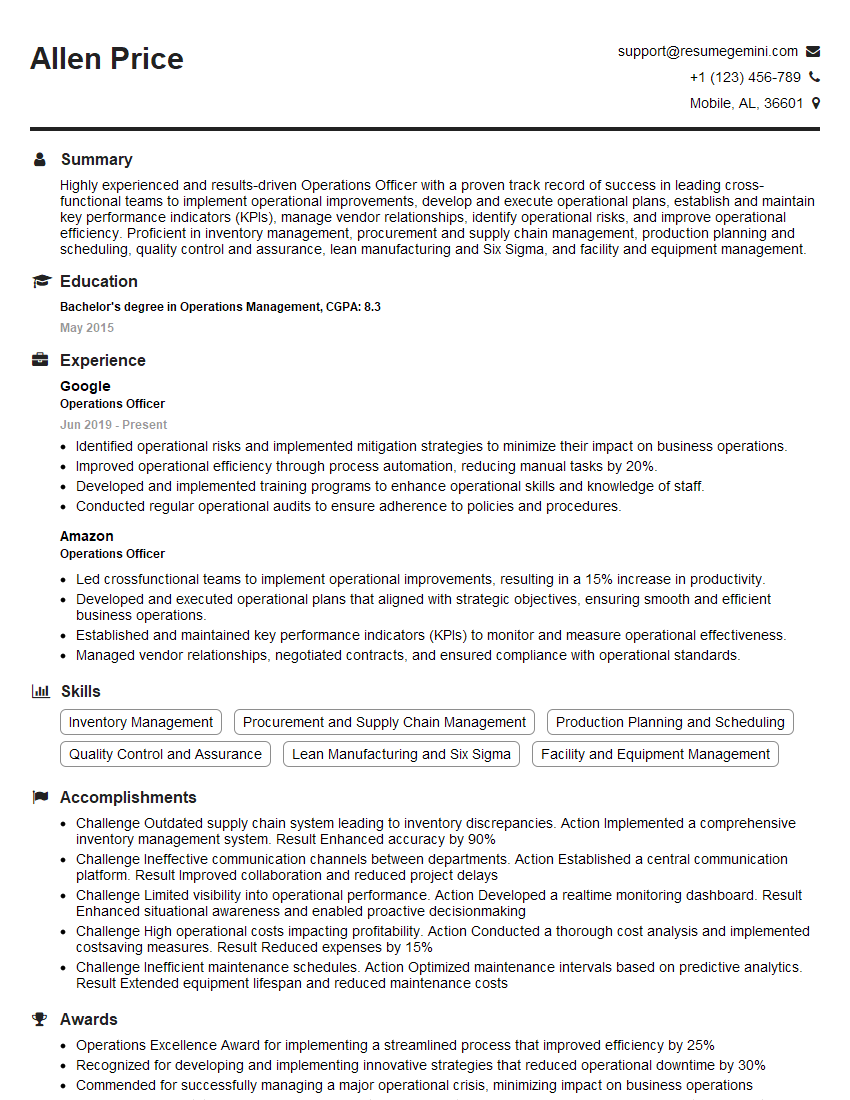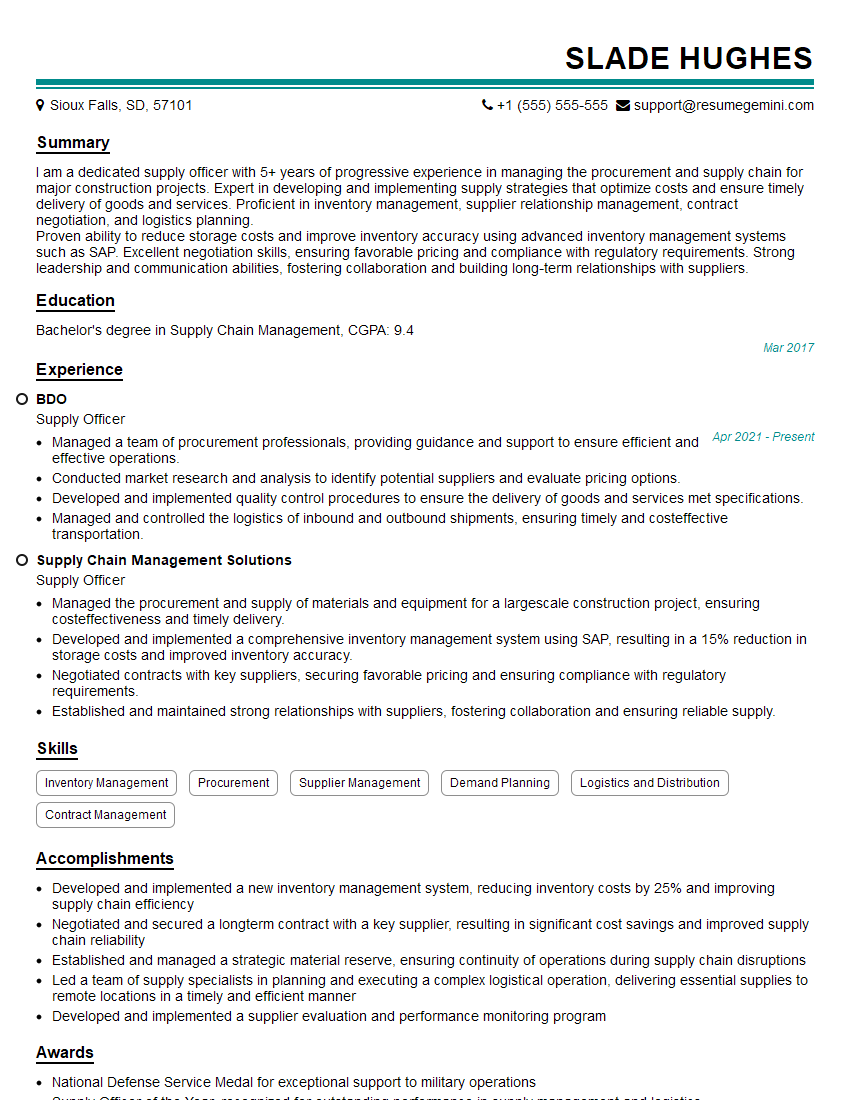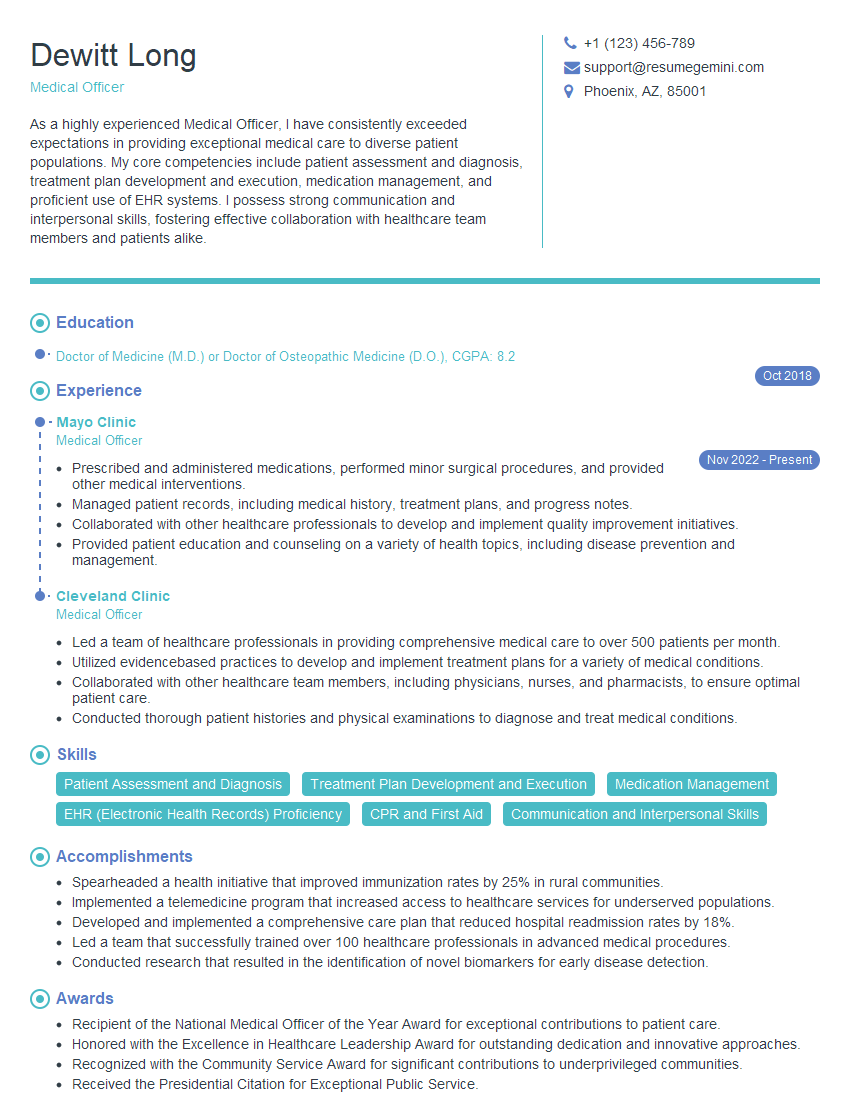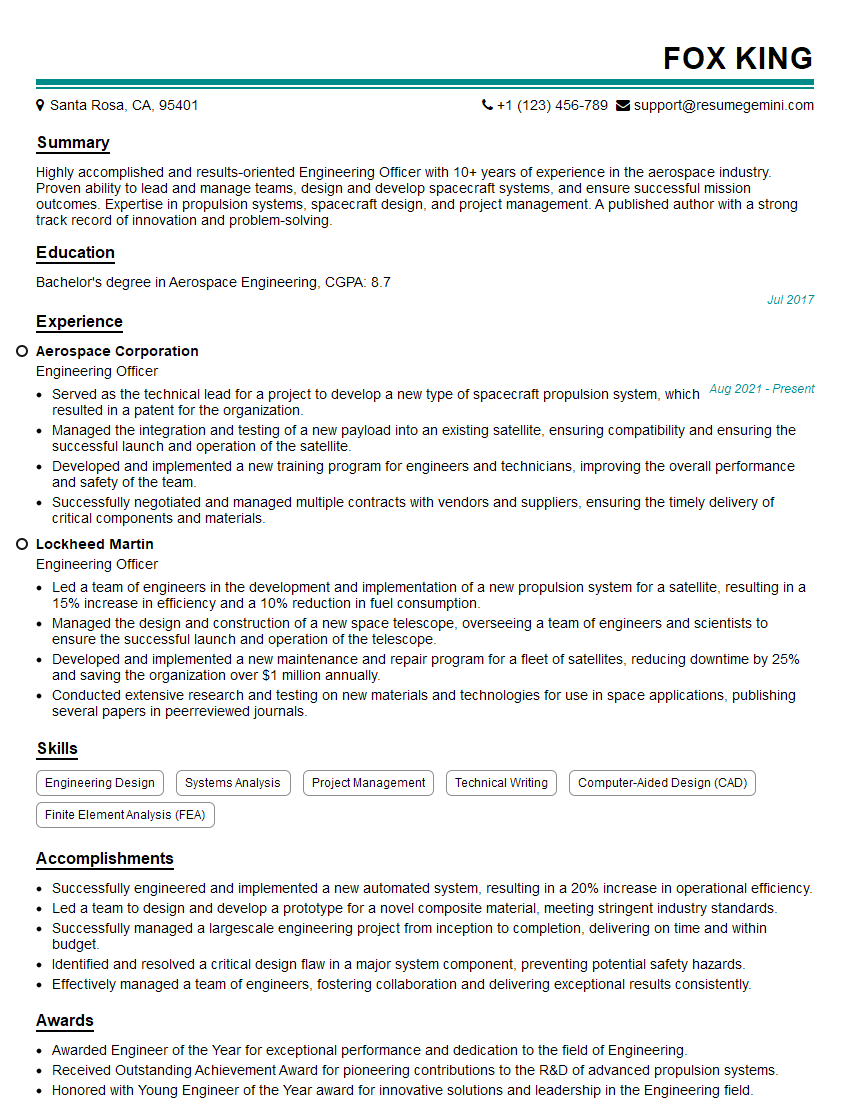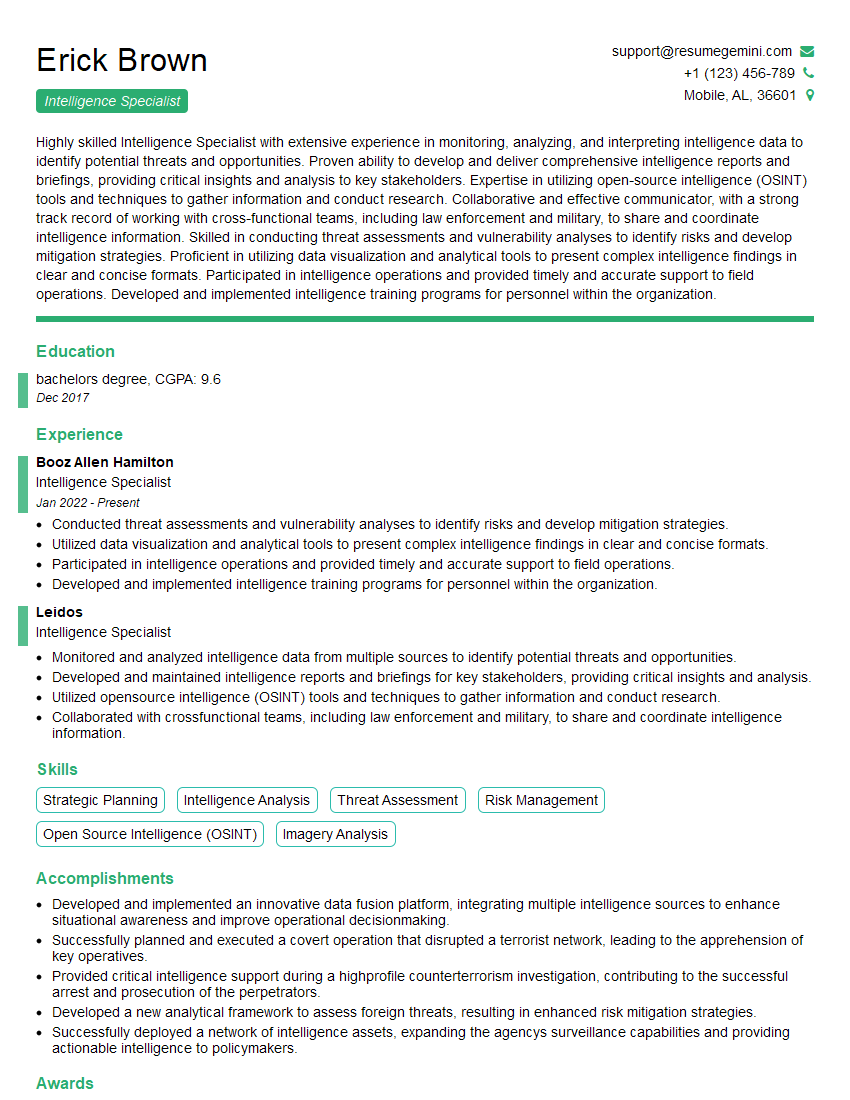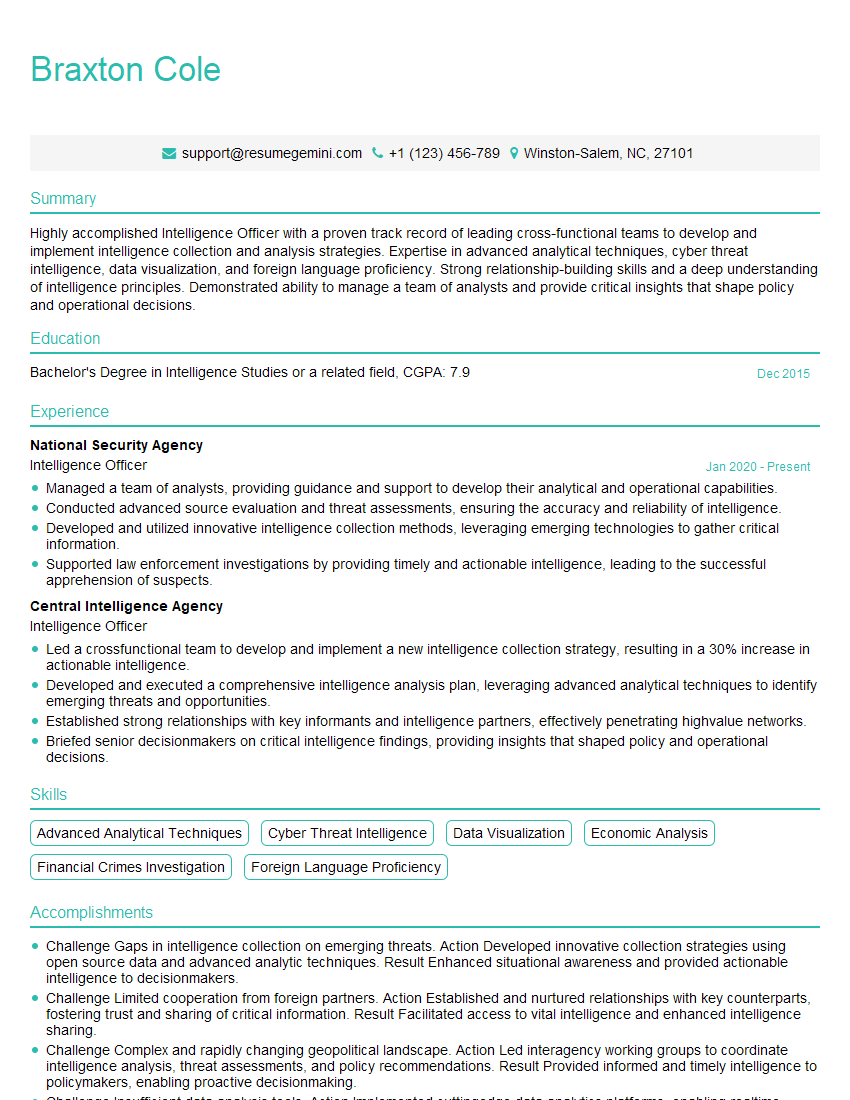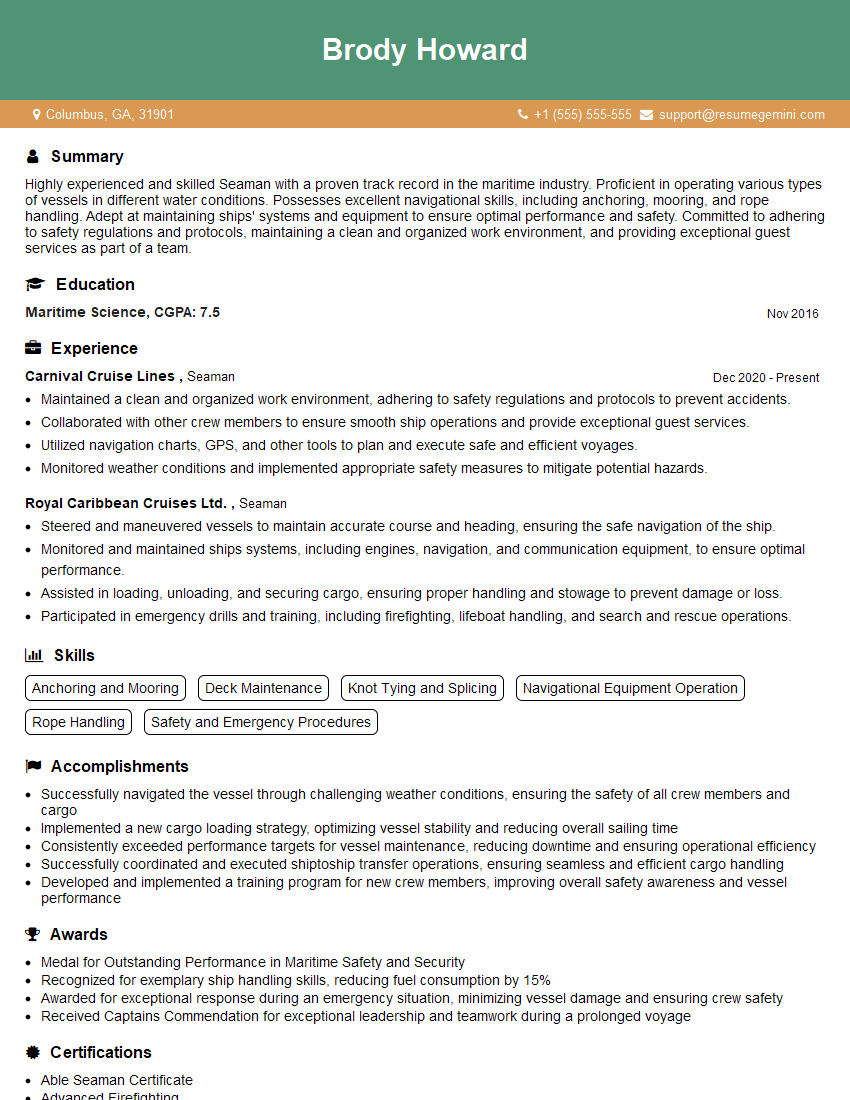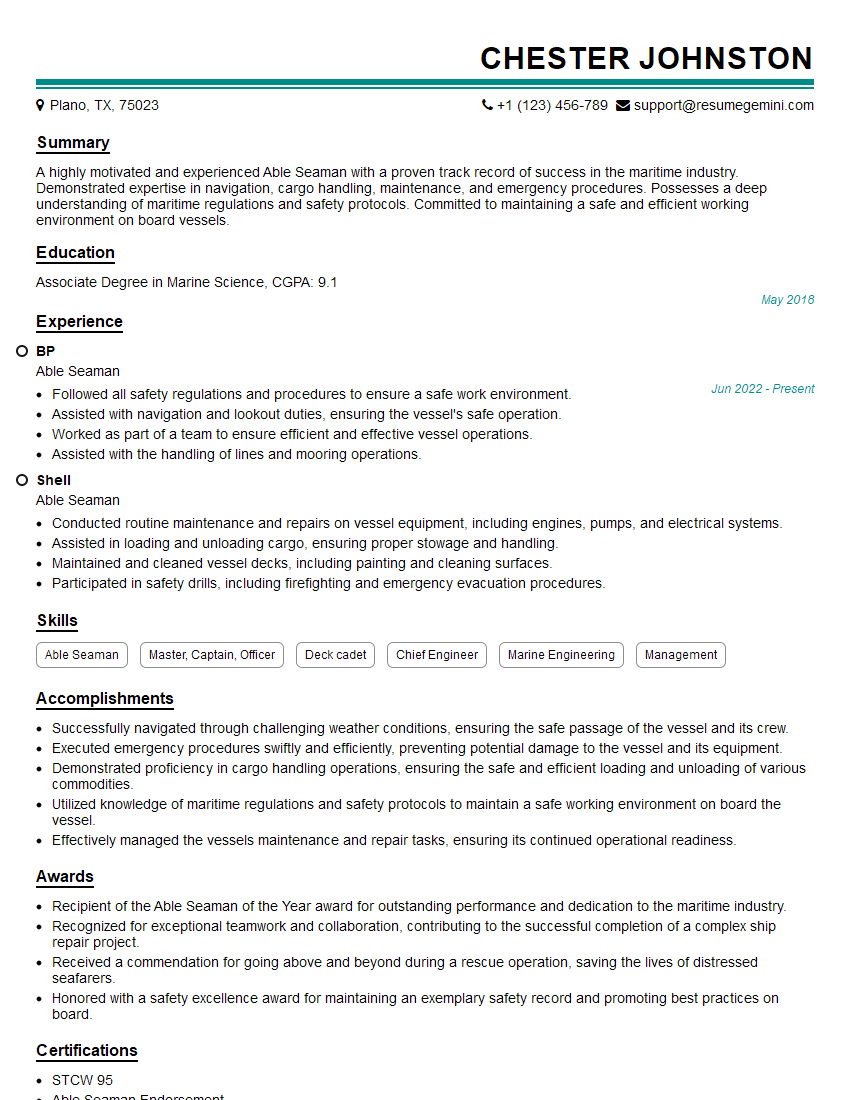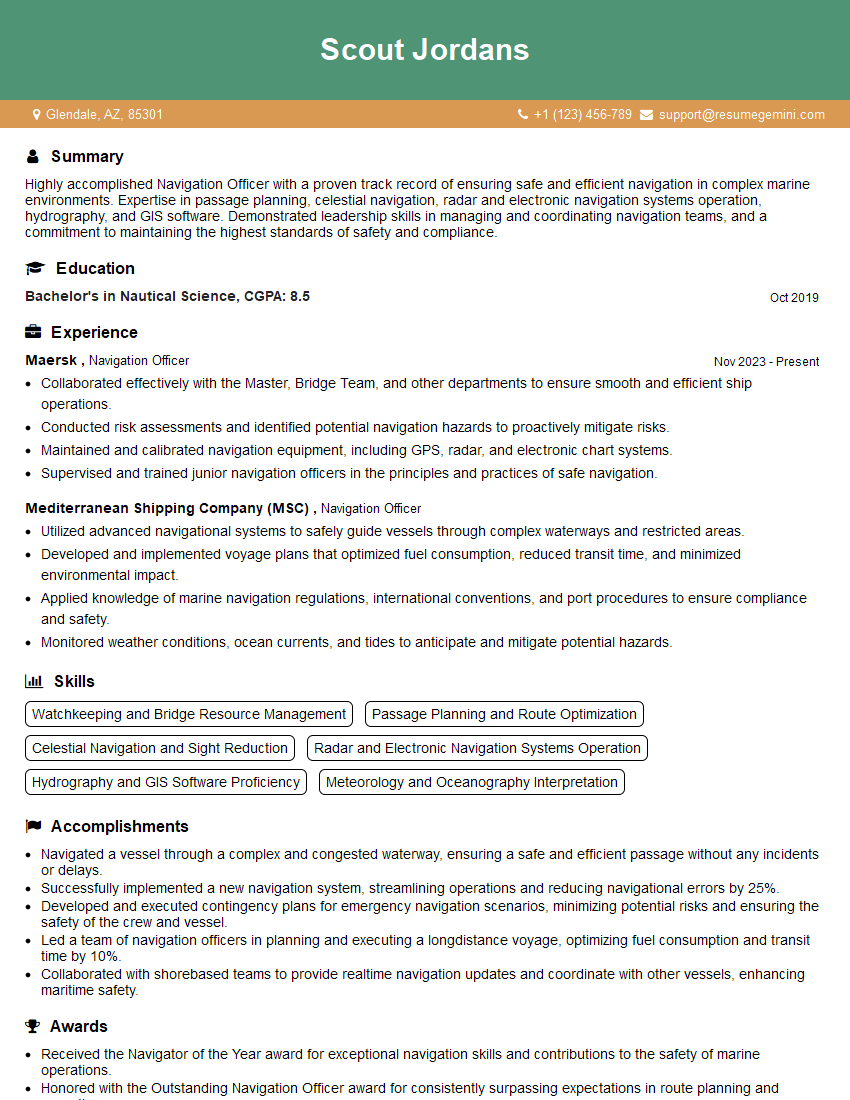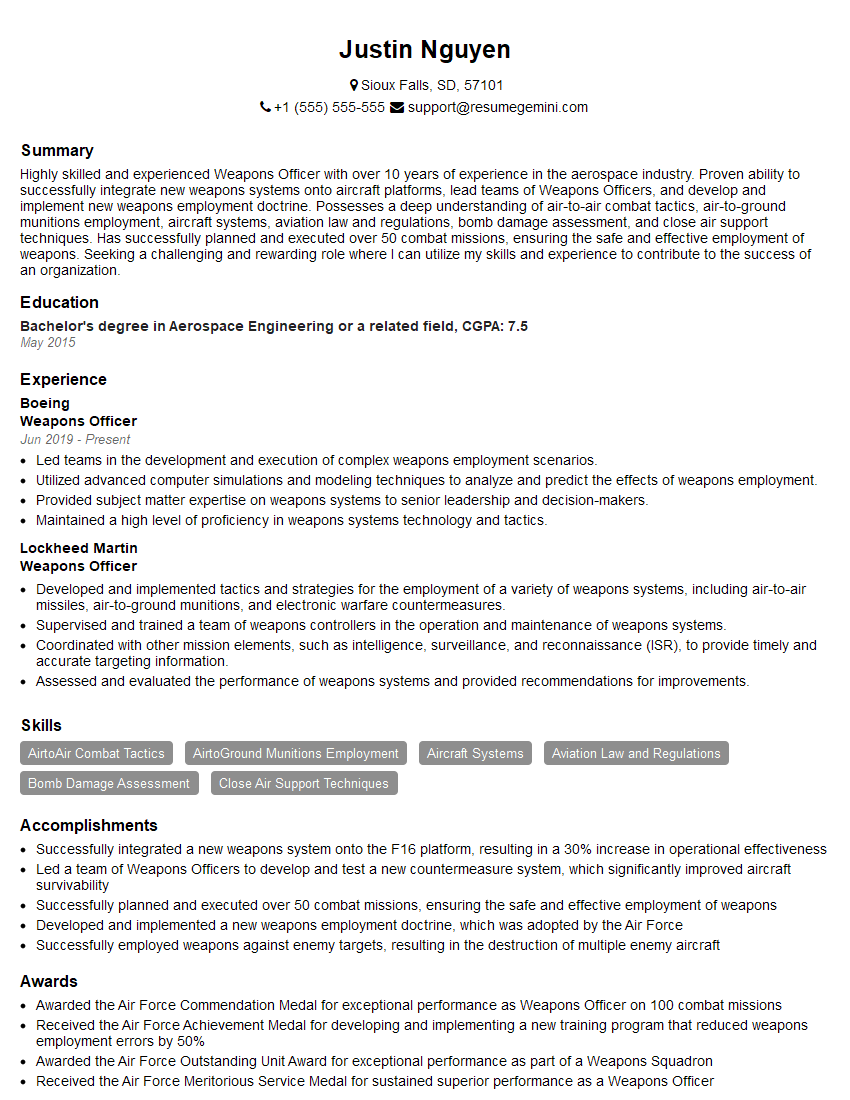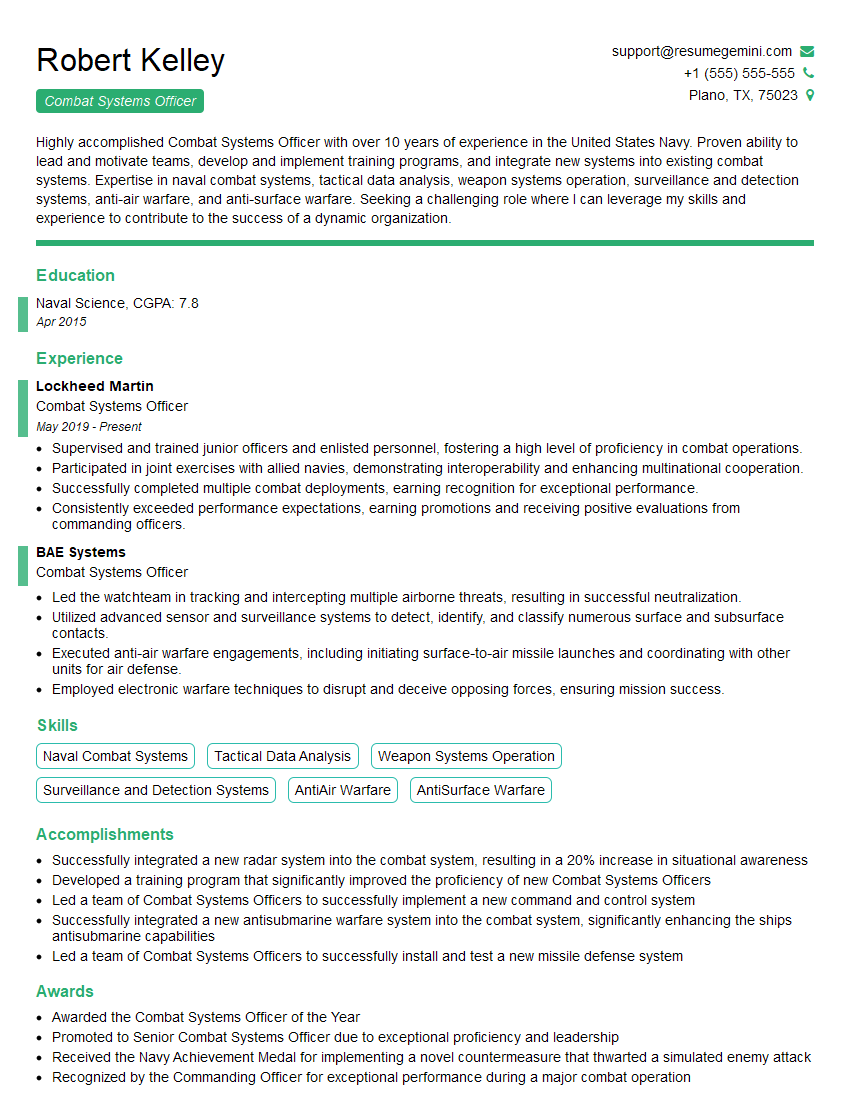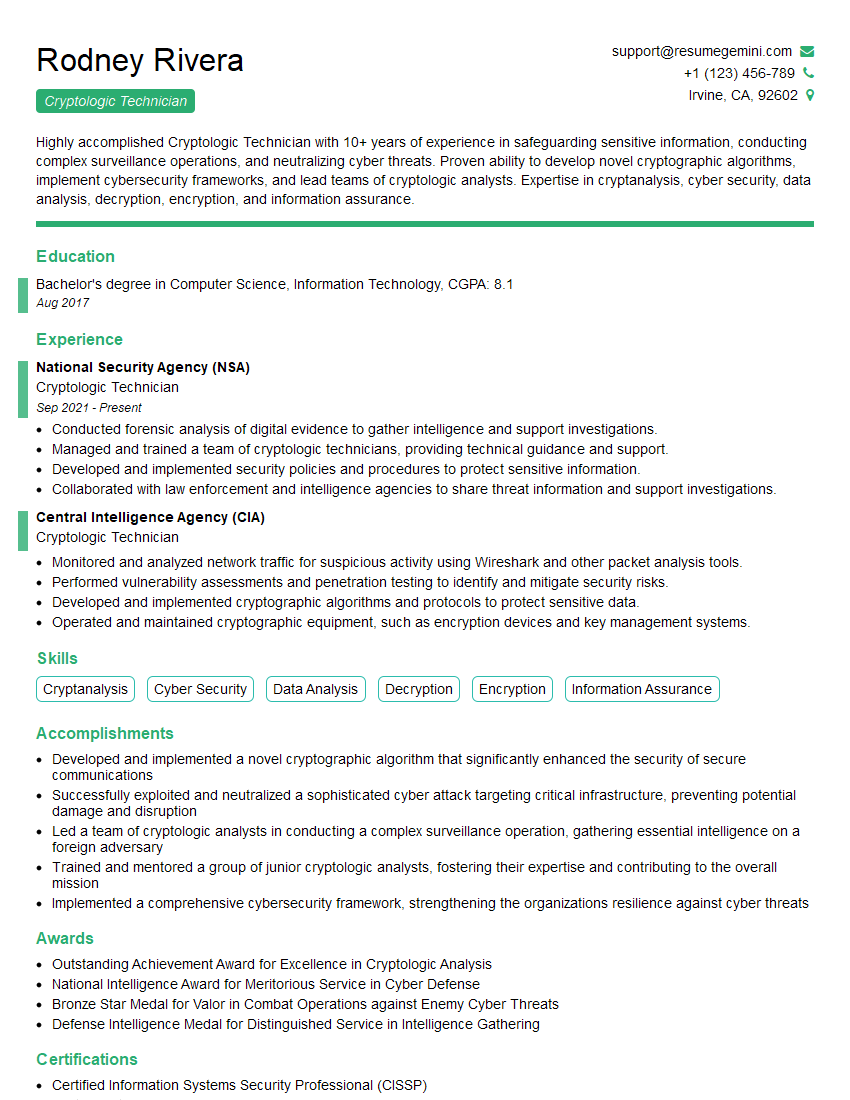The right preparation can turn an interview into an opportunity to showcase your expertise. This guide to Collaboration with Ships Crew and Other Warfare Specialists interview questions is your ultimate resource, providing key insights and tips to help you ace your responses and stand out as a top candidate.
Questions Asked in Collaboration with Ships Crew and Other Warfare Specialists Interview
Q 1. Describe your experience coordinating multi-disciplinary teams in a high-pressure environment.
Coordinating multi-disciplinary teams in high-pressure maritime environments demands a structured approach. It’s akin to conducting an orchestra – each section (navigation, engineering, weapons, communications) has its own expertise and tempo, yet they must harmonize seamlessly. My experience involves leading teams of up to 30 personnel across various specializations during complex operations, including anti-piracy missions and search and rescue. This involved meticulous planning, clear communication protocols, and regular debriefings to address challenges and refine strategies. For instance, during a search and rescue operation in rough seas, I leveraged the strengths of each team – the navigation team for precise location pinpointing, engineering for maintaining equipment functionality under stress, and the medical team for immediate patient care. Success in these high-stakes scenarios relies on proactive risk assessment, contingency planning, and the ability to swiftly adapt to unforeseen circumstances.
- Pre-operation briefing: Emphasizing individual roles and interdependencies.
- Real-time communication channels: Maintaining open lines of communication using both formal channels (e.g., bridge-to-engine room communication systems) and informal channels to allow for quick updates.
- Post-operation debrief: Identifying areas for improvement and reinforcing best practices.
Q 2. Explain your approach to resolving conflicts between crew members with differing skill sets.
Conflict resolution among crew members with varying skill sets requires a nuanced approach. It’s not about assigning blame, but about understanding the root cause of the disagreement. I typically employ a collaborative, problem-solving method, fostering a safe environment for open dialogue. This often begins with active listening to each party’s perspective, identifying the underlying needs and concerns, and then collaboratively devising solutions. For instance, a conflict between a highly experienced navigator and a newly-trained helmsman regarding navigation procedures might be resolved by creating a mentorship program, allowing the experienced navigator to guide the helmsman, build confidence, and foster understanding.
- Active listening: Understanding each individual’s point of view.
- Identifying underlying issues: Looking beyond surface-level disagreements.
- Collaborative problem-solving: Working together to find mutually agreeable solutions.
- Mediation (if necessary): Facilitating communication and helping parties reach a compromise.
Q 3. How would you handle a communication breakdown between the bridge and engineering during a critical operation?
A communication breakdown between the bridge and engineering during a critical operation is extremely dangerous. Immediate action is crucial. My approach involves a layered response:
- Verify the breakdown: Is it a complete failure or a partial loss of communication? Are alternative communication methods available (e.g., secondary radio systems, internal intercoms)?
- Establish communication: Utilize all available channels to re-establish contact. This may include sending a dedicated messenger if communication systems are down.
- Provide essential information: If communication is partially restored, prioritize critical information exchange. The bridge might need to relay vital navigational data while engineering needs to report critical system status updates.
- Implement contingency plans: If communication cannot be re-established quickly, pre-defined contingency plans should be immediately implemented based on the nature of the problem.
- Post-incident analysis: Following the resolution of the crisis, a comprehensive investigation is conducted to determine the root cause and prevent future incidents. This may involve reviewing communication logs and conducting interviews with crew members.
Q 4. Detail your experience using collaborative tools and technologies for maritime operations.
My experience encompasses a wide range of collaborative tools and technologies for maritime operations, from traditional methods to modern digital systems. I’m proficient in using integrated navigation systems (INS), electronic chart display and information systems (ECDIS), and vessel traffic service (VTS) systems. More advanced systems such as collaborative data management platforms for sharing real-time information on threat assessments, weather updates, and logistical details have also been integral to my work. For instance, the use of secure communication platforms enabled efficient dissemination of intelligence information during counter-piracy operations, leading to successful interventions.
- ECDIS: Electronic Chart Display and Information Systems for navigation.
- VTS: Vessel Traffic Services for communication and coordination.
- Secure communication platforms: For exchanging sensitive information during operations.
- Data management systems: For storing, processing, and sharing crucial operational data.
Q 5. Describe a situation where you had to adapt your communication style to effectively interact with different personality types within a crew.
Adapting communication style is paramount in maritime environments. During a challenging anti-smuggling operation, I encountered a conflict between a pragmatic, detail-oriented engineer and an assertive, results-driven weapons specialist. The engineer preferred detailed technical reports, while the specialist favored concise updates. To resolve this, I adjusted my approach. With the engineer, I provided ample time for explanations and addressed his concerns thoroughly. With the specialist, I focused on quick, decisive communication, highlighting the immediate impact of their actions. This dual approach ensured both individuals felt heard and valued, and promoted effective collaboration.
Q 6. How would you ensure effective information sharing amongst different warfare specialist teams during a complex mission?
Effective information sharing among warfare specialist teams during complex missions requires a structured approach. A common operating picture (COP) is essential. This could involve a central hub displaying real-time data from various sources, such as radar, sonar, and intelligence feeds. Clear communication protocols, including standardized reporting formats and designated communication channels, are vital. Pre-mission briefings that clearly define responsibilities and communication procedures are also crucial. Regular updates and debriefings help to ensure consistency and address any gaps in information.
- Common Operating Picture (COP): A centralized system for real-time data visualization.
- Standardized reporting formats: Ensuring consistent information exchange.
- Designated communication channels: Preventing information overload and ensuring clear lines of communication.
- Regular updates and debriefings: Maintaining synchronization among teams.
Q 7. Explain your understanding of chain of command and its role in effective team collaboration.
Understanding the chain of command is fundamental for effective team collaboration. It provides a clear structure for decision-making and accountability. In a maritime context, this often involves a hierarchical structure, with the captain at the apex. Effective collaboration isn’t about circumventing the chain of command; it’s about working *within* it to achieve shared goals. Transparent communication up and down the chain is essential. For example, a junior officer with a critical observation should report it to their immediate superior, who then escalates it if necessary. This structured approach prevents confusion, ensures accountability, and fosters a disciplined and efficient operational environment. Clear roles and responsibilities at each level are also vital.
Q 8. How do you prioritize tasks and delegate responsibilities within a large, diverse crew?
Prioritizing tasks and delegating responsibilities in a large, diverse crew requires a structured approach. I utilize a combination of methods, starting with a clear understanding of the mission’s objectives. This forms the basis for a prioritized task list, broken down into smaller, manageable components. I then leverage a skill-based matrix, matching specific tasks to crew members with the appropriate qualifications and experience. This ensures optimal task completion and efficient use of personnel. For example, during a complex operation involving both navigation and weapons systems, I’d assign experienced navigators to charting and course correction, while expert gunners would manage weapons systems. To further improve efficiency, I implement a daily briefing system where task assignments, progress, and potential challenges are discussed and adjusted. This fosters transparency and encourages proactive problem-solving. Finally, regular feedback sessions allow for constructive criticism, adjustments in delegation, and recognition of individual contributions, bolstering morale and teamwork.
- Mission Objectives First: Begin with the overall mission goals to establish task importance.
- Skill-Based Matrix: Match tasks to crew member expertise for optimal efficiency.
- Daily Briefings: Ensure transparency and proactive problem-solving.
- Feedback Sessions: Encourage improvement, recognition, and enhanced teamwork.
Q 9. Describe your experience with emergency procedures and crew response coordination.
My experience with emergency procedures and crew response coordination is extensive. I’ve participated in numerous drills and real-world scenarios, ranging from fire and flooding emergencies to man overboard situations and combat scenarios. My approach emphasizes clear, concise communication using established protocols. For instance, in a man overboard situation, immediate action is crucial. I’ve trained crews to follow a pre-determined sequence: initiating a ‘man overboard’ alert, launching a rescue boat, deploying emergency signaling devices, and establishing communication with other vessels. This is reinforced through regular, simulated drills that incorporate unexpected variables, pushing the crew to adapt and react effectively under pressure. Post-incident debriefs are vital; they allow analysis of what worked well, areas for improvement, and adjustments to protocols. This iterative learning process is key to ensuring consistent and effective response in future emergencies. I believe in fostering a culture of preparedness where every crew member understands their role and is confident in executing emergency procedures.
One instance I recall involved a fire in the engine room. The immediate response, guided by established protocols, was decisive. The engineering team efficiently isolated the affected area, combatting the fire while other crew members tackled evacuation procedures. The efficient response, honed through years of practice and effective leadership, minimized damage and ensured crew safety.
Q 10. How would you assess the training needs of a crew and implement a training plan?
Assessing training needs involves a multi-faceted approach. It begins with evaluating current crew competencies against the demands of the ship’s mission profile. I would employ a combination of methods including performance reviews, skills assessments (both practical and theoretical), and feedback from supervisors and peers. This data will identify skill gaps in areas such as navigation, damage control, weapons systems, and communication protocols. Based on these assessments, I’d develop a tailored training plan. This would incorporate a mix of classroom instruction, hands-on training, simulations, and on-the-job mentoring. Regular progress checks and feedback sessions would ensure that learning is effective and that the training plan is adapted as needed. Crucially, this training should address both technical skills and teamwork, communication, and leadership capabilities. For example, a crew member might be proficient in navigation but require additional training in crisis management and teamwork. This holistic approach ensures that the crew is fully prepared for all aspects of their responsibilities. The plan would also account for individual learning styles and incorporate regular performance assessments to track progress and make necessary adjustments.
Q 11. Explain your familiarity with different communication protocols used in naval operations.
My familiarity with naval communication protocols is extensive. I am proficient in using various systems, including:
- Voice communication: Using HF, VHF, and UHF radios for ship-to-ship, ship-to-shore, and internal communications.
- Data communication: Utilizing Link-11, Link-16, and other data links for secure and efficient transmission of tactical information.
- Satellite communication: Utilizing Inmarsat and other satellite systems for long-range communications.
Q 12. How would you build morale and maintain team cohesion during long deployments?
Maintaining morale and team cohesion during long deployments is vital. My approach is multi-pronged, focusing on fostering a positive and supportive shipboard environment. This starts with clear and consistent leadership; open communication ensures everyone feels heard and valued. I would organize regular social events like movie nights, games, and onboard competitions to alleviate boredom and encourage camaraderie. Providing opportunities for personal enrichment, like educational programs or hobby groups, promotes well-being. Recognizing and rewarding individual and team achievements, both big and small, reinforces positive behaviors and boosts morale. Moreover, maintaining open channels of communication with families ashore through various methods like email and video calls is crucial. This makes a huge difference in crew morale. Finally, ensuring equitable access to leisure activities and facilities is essential to maintaining a fair and equitable environment. This holistic strategy supports crew well-being and helps maintain a strong, cohesive unit throughout even the longest deployments.
Q 13. Describe your experience with crisis management and decision-making under pressure.
My experience in crisis management and decision-making under pressure is substantial. I approach such situations using a structured framework that prioritizes safety, efficient response, and effective communication. This begins with rapid assessment of the situation, gathering information from all available sources. A clear understanding of the situation’s scope and potential consequences is critical for effective planning. Next, I formulate a response strategy, considering various options and their potential outcomes. This often involves consulting with relevant experts within the crew. Decision-making is transparent and involves clear communication with the team, keeping them informed and engaged in the process. Finally, post-incident reviews are crucial; they provide valuable learning opportunities for improving future responses and highlighting areas of both individual and team success.
One example involved a critical engine malfunction during a storm. Quick assessment indicated potential for complete power loss. My team and I immediately implemented emergency procedures, initiating damage control and coordinating with the navigation team to find a safe harbor. The calm and decisive action taken averted a potential disaster. A thorough post-incident review resulted in revised emergency procedures to further improve our response capabilities.
Q 14. How do you ensure that all crew members understand their roles and responsibilities during an operation?
Ensuring all crew members understand their roles and responsibilities is fundamental to safe and effective operations. This begins with a thorough onboarding process that includes detailed familiarization with the ship’s systems, emergency procedures, and individual job descriptions. I utilize various training tools such as clear role-specific manuals, interactive simulations, and regular drills. These drills should cover a range of scenarios, from routine tasks to emergency situations, allowing crew members to practice their roles and build confidence. Regular briefings and discussions are also crucial for clarifying responsibilities, addressing questions, and identifying areas for improvement. In addition, using a visual aid like a detailed organizational chart helps to clarify reporting structures and responsibilities within the crew. The use of multi-modal learning methods caters to varying learning styles, thereby maximizing comprehension and retention. Open communication and ongoing feedback loops are key to achieving a situation where every crew member is confident and capable in carrying out their assigned tasks.
Q 15. Explain your approach to performance management and feedback within a crew.
Performance management within a ship’s crew requires a multifaceted approach that balances individual growth with overall team effectiveness. My strategy centers around regular, constructive feedback, both positive and corrective, delivered in a timely and respectful manner. This isn’t a once-a-year event; it’s an ongoing process.
- Regular Performance Reviews: Formal reviews provide a structured setting to assess individual progress against established goals and identify areas for improvement. I use a combination of quantitative data (e.g., task completion rates, safety records) and qualitative observations (e.g., teamwork, problem-solving skills).
- Regular Informal Feedback: Daily interactions provide ample opportunities for brief, positive reinforcement or immediate course correction. Catching small issues early prevents them from escalating. For instance, if a sailor consistently misses a safety protocol, a quick reminder is more effective than waiting for a formal review.
- 360-Degree Feedback: Where feasible and appropriate, incorporating feedback from peers and subordinates provides a more holistic view of an individual’s performance and contribution to the team dynamic. This helps to identify blind spots and foster a culture of mutual accountability.
- Development Plans: Based on performance reviews and feedback, I collaborate with each crew member to create personalized development plans outlining specific goals, training needs, and strategies for improvement. This demonstrates commitment to their growth and enhances engagement.
For example, during a recent mission, I noticed a junior officer struggling with navigation under stressful conditions. Instead of immediate criticism, I provided one-on-one coaching, offering practical tips and additional training opportunities. This approach fostered trust and improved their skills, ultimately benefiting the entire team.
Career Expert Tips:
- Ace those interviews! Prepare effectively by reviewing the Top 50 Most Common Interview Questions on ResumeGemini.
- Navigate your job search with confidence! Explore a wide range of Career Tips on ResumeGemini. Learn about common challenges and recommendations to overcome them.
- Craft the perfect resume! Master the Art of Resume Writing with ResumeGemini’s guide. Showcase your unique qualifications and achievements effectively.
- Don’t miss out on holiday savings! Build your dream resume with ResumeGemini’s ATS optimized templates.
Q 16. How do you handle sensitive information and maintain confidentiality within a military context?
Handling sensitive information in a military context demands strict adherence to established protocols and a deep understanding of the potential consequences of breaches. Confidentiality is paramount, and my approach focuses on several key principles.
- Need-to-Know Basis: Information is shared only with individuals who require it to perform their duties. I strictly avoid unnecessary dissemination.
- Secure Communication Channels: Sensitive discussions and data transfers utilize encrypted communication systems to protect against unauthorized access.
- Data Security Protocols: I ensure adherence to all established data security protocols, including password management, access control, and regular security audits.
- Physical Security: Sensitive documents and materials are stored in secure locations with restricted access.
- Reporting Procedures: Any suspected or actual security breaches are immediately reported through established channels. This includes both internal reporting within the team and to relevant higher authorities.
For instance, during a planning phase for a high-risk operation, only the essential team members with necessary clearances were privy to specific details of the mission plan. All communications related to this were encrypted, and meticulous record-keeping was maintained. This ensured operational security and minimized risk of compromise.
Q 17. Describe your experience working with international partners or allied forces.
My experience collaborating with international partners and allied forces spans several joint operations and exercises. Successful collaboration requires adaptability, cultural sensitivity, and a clear understanding of different operational procedures and communication styles.
- Cultural Awareness: I actively seek to understand the cultural nuances of my international colleagues, recognizing that communication styles and expectations may differ significantly. This includes understanding chain of command structures and decision-making processes within different militaries.
- Shared Operational Goals: Clear articulation of shared objectives is crucial. I work to establish common goals and ensure all parties are aligned in their understanding of the mission and objectives.
- Effective Communication: Open communication channels are essential. This involves regular briefings, clear reporting mechanisms, and a willingness to actively listen and address concerns. Utilizing interpreters or translators, as needed, is critical for accurate communication.
- Mutual Respect and Trust: Building rapport and establishing trust with international counterparts is fundamental to success. This takes time and effort but is crucial for effective collaboration. Open dialogue and demonstration of professionalism and mutual respect are key in forming positive working relationships.
In a recent multinational peacekeeping operation, I worked closely with a contingent from a different nation. By understanding their unique communication preferences and adapting my leadership style, I fostered trust and built strong collaboration which facilitated success.
Q 18. How would you maintain operational security and mitigate risks during a mission?
Maintaining operational security (OPSEC) and mitigating risks during a mission is a continuous, proactive process requiring vigilance and adherence to established protocols. My approach combines planning, execution, and post-mission review.
- Pre-Mission Planning: A thorough risk assessment identifies potential threats and vulnerabilities. This informs the development of mitigation strategies and contingency plans.
- Communication Control: Strict communication protocols are enforced, limiting the dissemination of information to a need-to-know basis. Use of secure channels and encryption is essential.
- Personnel Security: Crew members undergo security briefings and training to understand OPSEC principles and their individual responsibilities.
- Physical Security: Measures are put in place to secure sensitive equipment, facilities, and personnel. This may involve physical barriers, surveillance, and access control.
- Information Security: Protecting sensitive information requires vigilance to prevent leaks through various channels, both electronic and physical. This includes proper handling of classified documents and electronic data.
- Post-Mission Debriefing: After each mission, a thorough debriefing analyzes success and failures. Areas of improvement for OPSEC are identified and implemented.
For example, during a covert operation, we used strict radio silence protocols, employing secure communication channels for only essential exchanges. We also maintained a tight perimeter to maintain physical security. The post-mission review allowed us to identify gaps in our OPSEC practices and implement improvements for future operations.
Q 19. How do you facilitate open communication and ensure a positive team environment?
Facilitating open communication and a positive team environment requires a conscious effort to foster trust, respect, and mutual support. My approach relies on several key strategies.
- Open Door Policy: I encourage crew members to approach me with any concerns, questions, or suggestions, creating a safe space for open dialogue. This shows I value their input and fosters trust.
- Regular Team Meetings: Meetings provide a forum for updates, brainstorming, problem-solving, and open discussion. I ensure all voices are heard and that decisions are made transparently.
- Conflict Resolution: I provide training and guidance on conflict resolution techniques and actively mediate disagreements to ensure conflicts are resolved constructively and professionally.
- Team-Building Activities: Engaging in team-building activities fosters camaraderie and helps build stronger relationships. This can range from informal social events to organized activities.
- Recognition and Appreciation: Public acknowledgement of individual and team achievements fosters morale and reinforces positive behaviors.
During a particularly challenging period, I organized a team-building exercise that focused on problem-solving and collaboration. The activity fostered a stronger sense of unity and improved communication, resulting in increased team efficiency and morale.
Q 20. Describe your experience with safety procedures and risk mitigation in maritime operations.
Safety is paramount in maritime operations. My experience involves extensive knowledge and application of safety procedures and risk mitigation techniques.
- Risk Assessment: A thorough risk assessment is conducted before, during, and after each operation, identifying potential hazards and implementing appropriate preventative measures. This might include assessing weather conditions, equipment malfunctions, and human error.
- Safety Training: All crew members receive comprehensive safety training tailored to their roles and responsibilities. This includes drills and exercises to ensure familiarity with emergency procedures.
- Emergency Response Plans: Comprehensive emergency response plans are developed and regularly practiced, including fire drills, man overboard drills, and medical emergency response. This ensures the crew is well prepared to handle various scenarios.
- Equipment Maintenance: Regular maintenance and inspection of all equipment is conducted to prevent malfunctions and ensure safety. This includes lifeboats, safety gear, and navigational equipment.
- Compliance with Regulations: Strict adherence to all relevant international maritime safety regulations and standards is essential. This ensures legal compliance and enhances safety.
During a storm at sea, our adherence to safety protocols and rigorous training allowed us to successfully navigate the treacherous conditions and bring the vessel and crew safely to port. The regular drills and training directly translated into a safe and efficient response.
Q 21. How do you adapt your leadership style to different situations and crew members?
Adaptability is crucial in leadership, especially in a maritime environment. My leadership style is not fixed but rather adjusts based on the situation and the individuals involved. I believe in employing situational leadership, adapting my approach based on the maturity and skills of the crew member.
- Situational Awareness: I constantly assess the situation, considering the context, the task at hand, and the individuals involved. This includes the stress levels, the team dynamics, and the urgency of the situation.
- Delegation and Empowerment: I delegate tasks based on individual skills and experience. This empowers crew members, fosters trust, and develops their abilities.
- Directive vs. Supportive Leadership: In high-pressure situations or with less experienced crew, a more directive approach may be necessary. In other situations, a more supportive and collaborative style will be more effective.
- Communication Styles: I adapt my communication style to each individual, considering their personality and preferred methods of communication. Some might respond better to direct instructions while others prefer more collaborative discussions.
- Feedback and Coaching: I provide constructive feedback and coaching tailored to individual needs. This includes both positive reinforcement and constructive criticism, always delivered respectfully and aiming for growth.
For example, when leading experienced technicians, a more collaborative approach emphasizing shared decision-making was highly effective. With junior sailors, clearer, more direct instructions were necessary to ensure mission success. This flexible approach enhances team cohesion and overall efficiency.
Q 22. Explain your understanding of different warfare domains and their interdependencies.
Modern warfare is multifaceted, encompassing various domains intricately linked. These include land, sea, air, space, and cyberspace. Understanding their interdependencies is crucial for effective operations.
- Land warfare involves ground forces engaging in combat on land, impacting sea and air domains through the need for supply lines and air support.
- Maritime warfare focuses on naval operations, heavily reliant on intelligence from air and space domains (satellite imagery, for instance) and potentially engaging cyber warfare for disrupting enemy communications.
- Air warfare provides crucial support and direct combat capabilities, influencing land and sea operations through air superiority, precision strikes, and reconnaissance.
- Space warfare offers crucial surveillance and communication capabilities impacting all other domains, providing real-time information crucial for strategic decision-making. Disruption of space-based assets severely impacts other domains.
- Cyber warfare affects all domains by targeting computer systems, communication networks, and critical infrastructure, potentially crippling enemy capabilities across the board.
For example, a successful maritime operation might rely on satellite imagery from space to identify enemy vessels (space domain), air support for protection (air domain), and coordinated cyber attacks to disrupt enemy communication networks (cyber domain). These domains are not separate but function as a cohesive whole, needing seamless integration for maximum effectiveness.
Q 23. How would you leverage the unique skills of different warfare specialists to achieve mission objectives?
Leveraging diverse warfare specialist skills requires thoughtful planning and strong leadership. A clear understanding of individual strengths is paramount. For instance, I’d establish clear communication channels and integrate specialists into the mission planning phase.
- Intelligence specialists provide crucial pre-mission data, informing the operational plan and helping to anticipate potential threats. This would include situational awareness, threat analysis, and identification of potential vulnerabilities.
- Communications specialists ensure seamless information flow throughout the operation, enabling swift response to evolving situations. Maintaining secure and reliable communication channels are crucial.
- Weapons specialists need to be integrated into the operational plans, making sure their capabilities align with the mission objectives, providing precise and effective firepower.
- Navigation and engineering specialists ensure operational readiness of the platform, performing regular maintenance and navigating through potentially hazardous environments.
- Medical specialists are essential in ensuring the health and well-being of the crew, both during and after the mission.
During a recent mission, integrating a cyber warfare specialist allowed us to disrupt enemy communications, creating an operational advantage and limiting their response. Effective collaboration ensured that all specialists’ roles were complementary and contributed towards achieving the mission objective.
Q 24. Describe your experience with post-mission analysis and lessons learned.
Post-mission analysis is critical for continuous improvement. My approach involves a structured review process focusing on both successes and failures. This process typically involves:
- Data collection: Gathering data from various sources, including operational logs, debriefings, and sensor data.
- Analysis: Identifying key performance indicators (KPIs) to assess mission effectiveness. Did we achieve our objectives? What went well? Where did we fall short?
- Lessons learned: Documenting and sharing insights, identifying areas for improvement in training, procedures, equipment, and collaboration strategies.
- Dissemination: Sharing lessons learned with relevant personnel to prevent similar issues and enhance future mission planning and execution. This is crucial for organisational learning.
For example, after one mission, we found that communication delays between the navigation and weapons teams almost led to a critical incident. Our post-mission analysis identified a flaw in the communication protocols, which we subsequently corrected, leading to more effective teamwork in the future. It also led to updated training in crisis communication.
Q 25. How do you identify and address potential conflicts of interest amongst crew members?
Identifying and addressing conflicts requires proactive leadership and strong communication skills. I utilize a multi-pronged approach:
- Open communication: Fostering a culture where crew members feel comfortable expressing concerns without fear of reprisal. Regular crew meetings provide a platform for this.
- Clear roles and responsibilities: Defining clear roles and responsibilities minimizes overlap and potential for conflict. This reduces ambiguity and clarifies expectations.
- Mediation: If conflicts arise, I act as a mediator, facilitating constructive dialogue and helping crew members find mutually acceptable solutions. Maintaining impartiality is key.
- Fair and consistent disciplinary action: If necessary, implementing fair and consistent disciplinary measures ensures accountability and maintains order and discipline within the team.
In one instance, a conflict arose between two specialists over resource allocation. Through mediation, we identified the root cause – a lack of clarity in the initial allocation plan. Re-evaluating and clarifying the plan, along with open communication, resolved the conflict, strengthening teamwork.
Q 26. Explain your understanding of ethical considerations in maritime operations.
Ethical considerations are paramount in maritime operations. They involve adhering to international law, respecting human rights, and protecting the environment. Key considerations include:
- Rules of engagement: Strictly adhering to established rules of engagement, ensuring actions are justified and proportionate to the threat.
- Protection of civilians: Prioritizing the safety and well-being of civilians, minimizing collateral damage during operations. This requires careful planning and execution.
- Environmental protection: Minimizing the environmental impact of operations, adhering to international regulations regarding pollution and waste disposal.
- Respect for human dignity: Treating all individuals, regardless of nationality or affiliation, with respect and dignity, even during combat situations. Maintaining humanitarian principles during all operations.
Ethical dilemmas are a real possibility in maritime operations. For example, encountering a distressed vessel in international waters raises several ethical considerations regarding the duty to assist, the potential risks involved, and the legal implications of intervention.
Q 27. How would you ensure compliance with international laws and regulations during a mission?
Compliance with international laws and regulations is non-negotiable. My approach involves a multi-layered strategy:
- Thorough pre-mission planning: Conducting a comprehensive legal review of the planned operation to ensure compliance with relevant international laws, such as the Law of the Sea and any other applicable treaties.
- Crew training: Providing thorough training to all crew members on relevant international laws and regulations, focusing on potential legal pitfalls and ethical dilemmas.
- Continuous monitoring: Maintaining ongoing monitoring and documentation throughout the mission to ensure all actions remain within legal boundaries. This could include logging all actions and decisions.
- Post-mission review: Conducting a detailed legal review after the mission to identify any potential breaches and take corrective action if needed. This is critical to prevent future issues.
For example, prior to any operation near a foreign coastline, we would meticulously study the local maritime laws and regulations to avoid potential legal issues. Any deviation from the pre-approved plan needs a thorough assessment and authorization.
Q 28. Describe your experience in using technology to enhance collaboration and communication within a ship’s crew.
Technology plays a vital role in enhancing collaboration and communication aboard a ship. We utilize a range of technologies, including:
- Integrated communication systems: Utilizing secure communication systems which allow for seamless information exchange between different departments and crew members. This could include secure messaging, video conferencing, and data sharing platforms.
- Navigation and sensor integration: Integrating navigation systems with sensor data to provide a comprehensive situational awareness picture, enabling better decision-making. This helps the crew to understand the context and environment.
- Automated systems: Utilizing automated systems to streamline tasks, reducing workload and improving operational efficiency. Automated systems can manage tasks that would otherwise consume significant crew time and resource.
- Data analytics and visualization: Leveraging data analytics to visualize complex operational data, facilitating faster and more informed decision-making. This allows for easier understanding of complex information.
For example, the introduction of a ship-wide network allowed for real-time information sharing between the bridge, engineering, and weapons departments during a recent operation, improving our response to an unexpected equipment malfunction. This reduced response times and improved coordination.
Key Topics to Learn for Collaboration with Ships Crew and Other Warfare Specialists Interview
- Effective Communication Strategies: Understanding and employing various communication methods (verbal, written, non-verbal) in a high-pressure environment. This includes active listening, clear articulation, and adapting communication style to different personalities and ranks.
- Teamwork and Leadership in Maritime Settings: Practical application of teamwork principles within a diverse crew, including conflict resolution, delegation, and fostering a collaborative environment. Understanding leadership styles and their effectiveness in maritime operations.
- Interoperability and Information Sharing: Understanding the procedures and protocols for seamless information exchange between different departments (e.g., navigation, engineering, weapons) and external agencies. This includes secure communication channels and data handling practices.
- Emergency Response Procedures: Knowledge of emergency protocols and collaboration during critical incidents, including accident response, damage control, and search and rescue operations. This involves understanding roles, responsibilities, and communication chains.
- Cultural Sensitivity and Diversity: Recognizing and valuing the diverse backgrounds and perspectives of crew members from different nationalities and cultures. Demonstrating an understanding of cultural nuances in communication and teamwork.
- Problem-Solving and Decision-Making under Pressure: Applying analytical and critical thinking skills to solve complex problems efficiently and effectively within time constraints and under stressful conditions. This includes prioritizing tasks and making informed decisions.
- Maintaining Professionalism and Discipline: Understanding the importance of adhering to strict protocols, maintaining confidentiality, and demonstrating a professional demeanor at all times, even under pressure.
Next Steps
Mastering collaboration with ships’ crews and other warfare specialists is crucial for career advancement in this field. Strong teamwork and communication skills are highly valued, opening doors to leadership roles and specialized assignments. To significantly boost your job prospects, focus on creating an ATS-friendly resume that highlights your relevant skills and experience. ResumeGemini is a trusted resource that can help you build a professional and impactful resume. Examples of resumes tailored to Collaboration with Ships Crew and Other Warfare Specialists are available to provide you with a strong template for your own application.
Explore more articles
Users Rating of Our Blogs
Share Your Experience
We value your feedback! Please rate our content and share your thoughts (optional).
What Readers Say About Our Blog
Hello,
We found issues with your domain’s email setup that may be sending your messages to spam or blocking them completely. InboxShield Mini shows you how to fix it in minutes — no tech skills required.
Scan your domain now for details: https://inboxshield-mini.com/
— Adam @ InboxShield Mini
Reply STOP to unsubscribe
Hi, are you owner of interviewgemini.com? What if I told you I could help you find extra time in your schedule, reconnect with leads you didn’t even realize you missed, and bring in more “I want to work with you” conversations, without increasing your ad spend or hiring a full-time employee?
All with a flexible, budget-friendly service that could easily pay for itself. Sounds good?
Would it be nice to jump on a quick 10-minute call so I can show you exactly how we make this work?
Best,
Hapei
Marketing Director
Hey, I know you’re the owner of interviewgemini.com. I’ll be quick.
Fundraising for your business is tough and time-consuming. We make it easier by guaranteeing two private investor meetings each month, for six months. No demos, no pitch events – just direct introductions to active investors matched to your startup.
If youR17;re raising, this could help you build real momentum. Want me to send more info?
Hi, I represent an SEO company that specialises in getting you AI citations and higher rankings on Google. I’d like to offer you a 100% free SEO audit for your website. Would you be interested?
Hi, I represent an SEO company that specialises in getting you AI citations and higher rankings on Google. I’d like to offer you a 100% free SEO audit for your website. Would you be interested?
good
